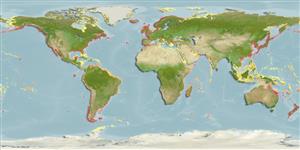Owenia fusiformis delle Chiaje, 1841
Tubeworm| Native range | All suitable habitat | Point map | Year 2050 |

|
| This map was computer-generated and has not yet been reviewed. |
| Owenia fusiformis AquaMaps Data sources: GBIF OBIS |
Upload your photos
Google image |
No photo available for this species.No drawings available for Oweniidae.
Google image |
No photo available for this species.
Classification / Names Common names | Synonyms | CoL | ITIS | WoRMS
Polychaeta | Canalipalpata | Oweniidae
Environment: milieu / climate zone / depth range / distribution range Ecology
Benthic; brackish; depth range 3 - 237 m (Ref. 112705). Tropical
Distribution Countries | FAO areas | Ecosystems | Occurrences | Introductions
Indo-West Pacific, Atlantic Ocean, Arctic and the Mediterranean.
Length at first maturity / Size / Weight / Age
Maturity: Lm ? range ? - ? cm Max length : 10.0 cm TL male/unsexed; (Ref. 7882)
Species' maximum length from the Belgian part of the North Sea (Ref. 7882). Length based from occurrence record; to be replaced with better reference. Maximum depth from Ref. 117328. Inhabits sandbanks and muddy bottoms of estuaries and inshore areas (Ref. 96352) and along the near-coastal zone. A tube-dwelling bristle worm, preferring fine to coarse sediment with 10 to 40% mud content. Its flexible tube, longer than the worm itself and made up of cemented sand grains and shell fragments, allows it to withdraw inward and the tube to subsequently bend down (Ref. 7882). A filter- and suspension feeder (Ref. 75621). Capable of surface deposit feeding (Ref. 87179). Feeds on organic detritus (Ref. 96352) and small invertebrates (Ref. 87179).
Life cycle and mating behavior Maturity | Reproduction | Spawning | Eggs | Fecundity | Larvae
Members of the class Polychaeta are mostly gonochoric (sexual). Mating: Females produce a pheromone attracting and signalling the males to shed sperm which in turn stimulates females to shed eggs, this behavior is known as swarming. Gametes are spawned through the metanephridia or body wall rupturing (termed as "epitoky", wherein a pelagic, reproductive individual, "epitoke", is formed from a benthic, nonreproductive individual, "atoke"). After fertilization, most eggs become planktonic; although some are retained in the worm tubes or burrowed in jelly masses attached to the tubes (egg brooders). Life Cycle: Eggs develop into trocophore larva, which later metamorph into juvenile stage (body lengthened), and later develop into adults.
Main reference
References | Coordinator | Collaborators
López-Jamar, E., G. González and J. Mejuto. 1986. (Ref. 2778)
IUCN Red List Status (Ref. 130435)
CITES status (Ref. 108899)
Not Evaluated
CMS (Ref. 116361)
Not Evaluated
Threat to humans
Human uses
| FishSource |
Tools
More information
Internet sources
BHL | BOLD Systems | CISTI | DiscoverLife | FAO(Publication : search) | Fishipedia | GenBank (genome, nucleotide) | GloBI | Gomexsi | Google Books | Google Scholar | Google | PubMed | Tree of Life | Wikipedia (Go, Search) | Zoological Record
Estimates based on models
Preferred temperature
(Ref. 115969): 1.9 - 17.3, mean 7.3 (based on 218 cells).
Price category
(Ref. 80766):
Unknown.


